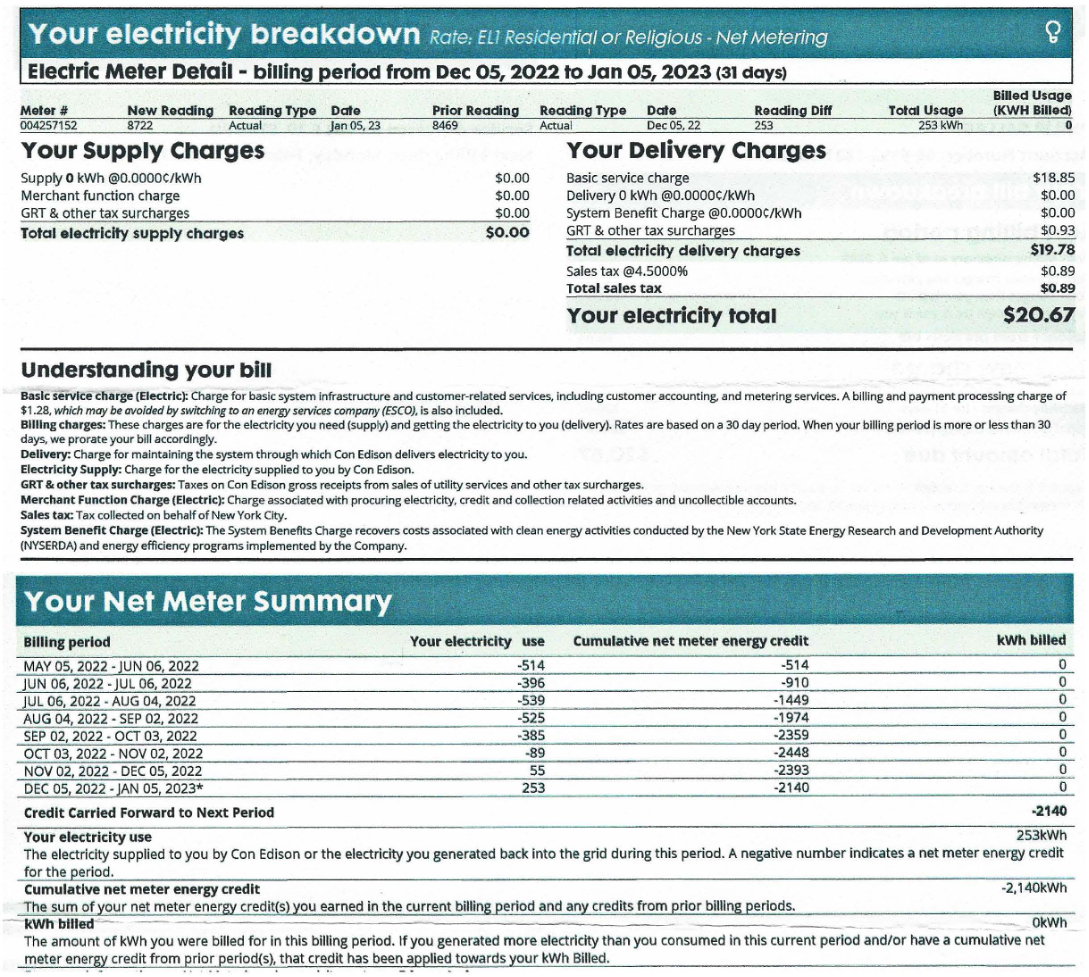This week, we have a follow-up guest post from my friend Phil Gallagher updating us on his “going solar” journey.

It’s been about seven months since I reported on the solar panels we installed last April 15; time for an update. Last July I noted that we received our first invoice from Con Edison: we were paying about $21 for delivery of electricity and $0.00 for electricity itself. Since we spent 110 days at our Maine hide-away between mid-June and early October, that first Con Edison bill didn’t really tell us much—we weren’t using their electricity because we weren’t here in Brooklyn.
We’ve been home in Brooklyn for a little over 5 months so we’re back to using Con Ed’s electricity once the sun goes down and on very cloudy days. As Con Ed’s invoice and net metering report for the period from December 5, 2022 to January 5, 2023 shows, we used more energy from the grid than in brighter months with longer days; during the winter we’ve been largely drawing on what was generated and ‘banked’ in the 110 days when we weren’t here. Bottom line: our monthly Con Ed payment is still less than $21.

In analyzing the net value of our solar panel installation there are a number of factors to consider; I’ll mention just two of the most important. Starting in late November and continuing to the present (March 10, 2023), we’re using 30% less natural gas from National Grid to heat the house. This is partially due to the fact that we’ve been using our LG mini-split system to heat individual rooms. Since the outside temperature has gotten into the low 40s and 30s we’ve been using our gas-driven circulating hot-water heating system for only 30 minutes most mornings to warm the house; we’re using our electricity-driven mini-split system to keep specific rooms at 72 degrees throughout the day. We have mini-split units in 4 rooms; each can be controlled separately, enabling the heating of the kitchen or the living room or my wife’s office or the master bedroom without heating rooms that are unoccupied. Another factor keeping energy use less than in previous years has been the weather: this has been a warm winter so far. To fully analyze our savings in energy costs we’d have to have data from a number of years.
By late spring I hope to have additional data from both electric and gas bills. Another type of data may also be available: the money we’re getting back from federal, state, and NYC tax incentives. We’ll see our tax accountant soon. By early June there should be more data on which to judge the overall results of our solar panel installation. Until then this report can only be considered a report in progress, but it’s encouraging. As for the future, I can announce that we are retiring our ‘restaurant’ gas stove (a Garland) which we’ve had for about 40 years and have ordered a fully electric LG induction range which we should receive by early April. Stay tuned.

Great insights in this post! I’ve been researching similar strategies and found that consistency really makes a difference. Thanks for sharing such valuable content.
Your vulnerability and honesty in your posts is truly admirable Thank you for being so open and authentic with your readers
Love Phil’s posts!